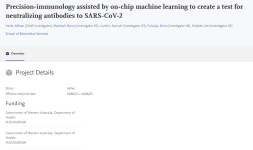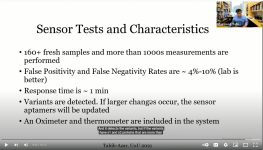IndepthDiver
Regular
As a few members have requested, I'm creating a new thread for my post about the recent news article on the Queensland Examin breathalyser. Some are wondering:
a) why the Queensland breathalyser received a $650k government grant when Biotome (Brainchip's partner) only received a $20k government grant, and
b) if the breathalyser is a competitor or an Akida embedded product.

 www.9news.com.au
www.9news.com.au
a) Grant funding
Recently there was an article doing the rounds which inferred Biotome received a $20,000 grant from the WA government. Some were wondering why Biotome only received a $20,000 grant while this new Queensland breathalyser received a $650,000 grant.
Just to clarify Biotome was given a $225,000 research grant by the WA government (this is in the original grant funding documentation, see bottom entry on the table screenshot below). The $20k grant value seems to be incorrect and IMO is an administrative error, as the funding comes from the same source as the $225,000 grant (the WA State government).
Secondly, the $650k grant appears to be a federal grant. The federal government is bigger than State so typically federal grants are higher value. Biotome has only received a State grant but there is always the possibility of them receiving a federal one in the future.
fhrifund.health.wa.gov.au

Misleading $20k grant


b) Breathalyser
There is no indication from the article that the Queensland Examin breathalyser is an Akida embedded product. Which leaves the possibility that it may be a competitor to the Akida-embedded Nanose breathalyser.
Here's what we know about the Queensland Examin breathalyser: *Note that I have updated this today based on further research
The time frame for getting results back by this device is significantly longer than is the case for Nanose. The below article indicates the Queensland device takes 60 seconds to return a result.
It's not clear if the analysis is being done on the device itself. Given it takes 60 seconds to get a QR code result back, this either means:
-it's being sent off to the cloud for analysis, OR
-it's being analysed very slowly on the device.
There's no indication of power consumption. Assuming it's battery operated, how long will it last till needing to be charged?
How does it compare to the Nanose device?
From memory the Nanose device can return results back in the order of ~3 seconds. An additional 30 seconds is required to use gas to purge the device. This is very different to waiting 60 seconds for a QR code. Nanose also doesn't need an internet connection so can be operated anywhere at any time as it is self-sufficient. We also know an Akida chip can run at maximum capacity on a AAA battery for 6 months, which indicates a Nanose device powered by Akida would be able to last this long as well. If this Queensland device isn't powered by Akida, and if it potentially using most of it's power to send data back and forth to the internet it will not last that long.
In short, Nanose is a significantly superior device.
Further information about the sensor / device operation can be found in the Youtube video below. This was uploaded 5 months ago and features Prof. Massoud Tabib-Azar, the Utah university partner of the Examin breathalyser.
a) why the Queensland breathalyser received a $650k government grant when Biotome (Brainchip's partner) only received a $20k government grant, and
b) if the breathalyser is a competitor or an Akida embedded product.
New breathalyser COVID-19 test developed in Queensland
a) Grant funding
Recently there was an article doing the rounds which inferred Biotome received a $20,000 grant from the WA government. Some were wondering why Biotome only received a $20,000 grant while this new Queensland breathalyser received a $650,000 grant.
Just to clarify Biotome was given a $225,000 research grant by the WA government (this is in the original grant funding documentation, see bottom entry on the table screenshot below). The $20k grant value seems to be incorrect and IMO is an administrative error, as the funding comes from the same source as the $225,000 grant (the WA State government).
Secondly, the $650k grant appears to be a federal grant. The federal government is bigger than State so typically federal grants are higher value. Biotome has only received a State grant but there is always the possibility of them receiving a federal one in the future.
Future Health Research and Innovation Fund - FHRI Focus Grants - COVID-19
Media statement announcing a COVID-19-related research, innovation and infrastructure funding recipientsfhrifund.health.wa.gov.au
Misleading $20k grant
Precision-immunology assisted by on-chip machine learning to create a test for neutralizing antibodies to SARS-CoV-2
research-repository.uwa.edu.au
b) Breathalyser
There is no indication from the article that the Queensland Examin breathalyser is an Akida embedded product. Which leaves the possibility that it may be a competitor to the Akida-embedded Nanose breathalyser.
Here's what we know about the Queensland Examin breathalyser: *Note that I have updated this today based on further research
The time frame for getting results back by this device is significantly longer than is the case for Nanose. The below article indicates the Queensland device takes 60 seconds to return a result.
It's not clear if the analysis is being done on the device itself. Given it takes 60 seconds to get a QR code result back, this either means:
-it's being sent off to the cloud for analysis, OR
-it's being analysed very slowly on the device.
There's no indication of power consumption. Assuming it's battery operated, how long will it last till needing to be charged?
How does it compare to the Nanose device?
From memory the Nanose device can return results back in the order of ~3 seconds. An additional 30 seconds is required to use gas to purge the device. This is very different to waiting 60 seconds for a QR code. Nanose also doesn't need an internet connection so can be operated anywhere at any time as it is self-sufficient. We also know an Akida chip can run at maximum capacity on a AAA battery for 6 months, which indicates a Nanose device powered by Akida would be able to last this long as well. If this Queensland device isn't powered by Akida, and if it potentially using most of it's power to send data back and forth to the internet it will not last that long.
In short, Nanose is a significantly superior device.
Further information about the sensor / device operation can be found in the Youtube video below. This was uploaded 5 months ago and features Prof. Massoud Tabib-Azar, the Utah university partner of the Examin breathalyser.







